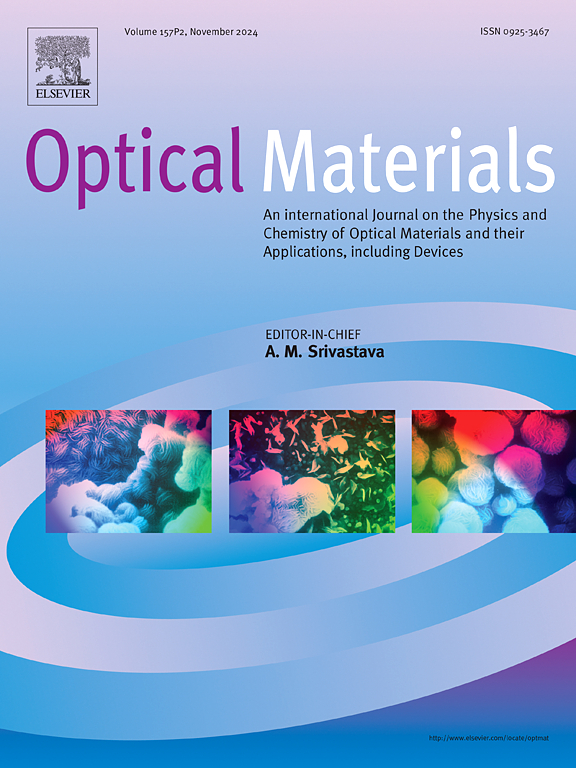Superior photo-diode performance of dual-phase ZrO2 spheres as interfacial layers in Cu/ZrO2/n-Si MIS structured Schottky barrier diode
IF 3.8
3区 材料科学
Q2 MATERIALS SCIENCE, MULTIDISCIPLINARY
引用次数: 0
Abstract
In this present work, ZrO2 interfacial layers were formed using a unique Jet Nebulizer Spray Pyrolysis (JNSP) technique at various mole concentrations of 0.10, 0.15, 0.20 and 0.25 M. This technique facilitated the fabrication of highly sensitive devices exhibiting positive photo-responses to the dual-phase ZrO2 structure between copper (Cu) as the metal and n-type silicon (n-Si) as the semiconductor. XRD revealed orthorhombic-to-cubic phase transitions with increasing crystallite size of 20 nm as the molar concentration rises. FE-SEM showed a morphological shift from cuboidal to spherical nanoparticles with higher concentrations. UV–Vis spectroscopy indicated an enhanced optical absorption and a widened bandgap (4.00 eV). XPS confirmed the presence of Zr4+ and O2− ions, aligning with EDAX and XRD results. Cu/ZrO2/n-Si MIS diodes exhibited improved performance under light and dark conditions, with a decreased (n = 2.10) under illumination and increased ФB (0.742 eV). Significant improvements were seen in photo-diode parameters like Photo-sensitivity (PS), Responsivity (R), Quantum Efficiency (QE), and Detectivity (D∗), with detectivity rising to 1.19 × 107 Jones. These results demonstrate Cu/ZrO2/n-Si MIS diodes potential for advanced photovoltaic devices and photodetector applications.

双相ZrO2球作为Cu/ZrO2/n-Si MIS结构肖特基势垒二极管界面层具有优异的光电二极管性能
在本工作中,采用独特的喷射雾剂喷雾热解(JNSP)技术在不同摩尔浓度(0.10,0.15,0.20和0.25 m)下形成ZrO2界面层,该技术有助于制作高灵敏度器件,该器件对铜(Cu)作为金属和n型硅(n-Si)作为半导体的双相ZrO2结构具有积极的光响应。XRD显示,随着摩尔浓度的增加,晶体尺寸增加到20 nm,晶型由正交向立方转变。FE-SEM显示,纳米颗粒的形貌由立方体向球形转变,且浓度较高。紫外可见光谱表明,该材料的光吸收增强,带隙变宽(4.00 eV)。XPS证实了Zr4+和O2−离子的存在,与EDAX和XRD结果一致。Cu/ZrO2/n- si MIS二极管在明暗条件下均表现出较好的性能,在光照条件下衰减(n = 2.10),增大ФB (0.742 eV)。光敏度(PS)、响应度(R)、量子效率(QE)和探测率(D *)等光电二极管参数均有显著改善,探测率提高到1.19 × 107 Jones。这些结果证明了Cu/ZrO2/n-Si MIS二极管在先进光伏器件和光电探测器应用中的潜力。
本文章由计算机程序翻译,如有差异,请以英文原文为准。
求助全文
约1分钟内获得全文
求助全文
来源期刊

Optical Materials
工程技术-材料科学:综合
CiteScore
6.60
自引率
12.80%
发文量
1265
审稿时长
38 days
期刊介绍:
Optical Materials has an open access mirror journal Optical Materials: X, sharing the same aims and scope, editorial team, submission system and rigorous peer review.
The purpose of Optical Materials is to provide a means of communication and technology transfer between researchers who are interested in materials for potential device applications. The journal publishes original papers and review articles on the design, synthesis, characterisation and applications of optical materials.
OPTICAL MATERIALS focuses on:
• Optical Properties of Material Systems;
• The Materials Aspects of Optical Phenomena;
• The Materials Aspects of Devices and Applications.
Authors can submit separate research elements describing their data to Data in Brief and methods to Methods X.
 求助内容:
求助内容: 应助结果提醒方式:
应助结果提醒方式:


